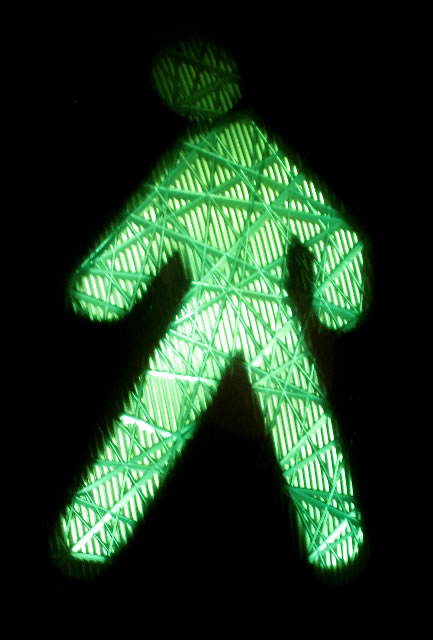
Art on streetscape | holding construction and the impending quietude in the wait for financing
Still, most people are waiting for financing; that is, the banks, while mostly funded back in government bailouts, repaid in context, other major projects are sitting and waiting; developers, people, are hungry to roll. Girvin was curious about what to do on that front, and in the close of 2009, when the rampage was just really getting underway. We approached companies exploring that idea rethinking their sense about place — what’s the story in the environment, can it be rethought in some manner? Could a dead space become something else? There are several paths — one, to the concept of completely repositioning buildings, the notion of branding buildings, building brand(ing). Identity in place — newly made. We’ve noted that proposition here.
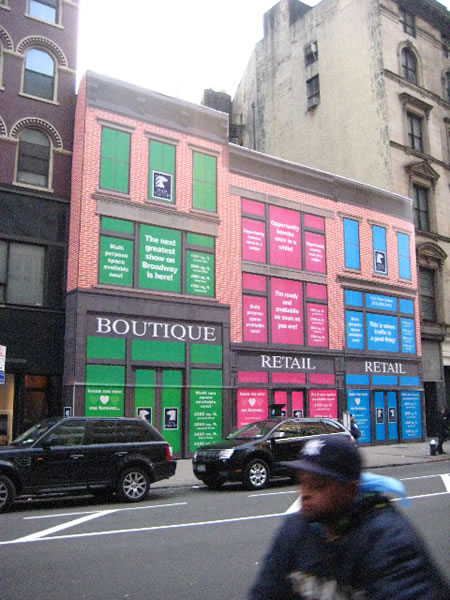
Another might be reuse — the shell simply being newly registered to suggest marketing. That might range from the nature of “your name here”, to the intimation of freshly envisioned shop-skins as new shopfronts, newly framed — amusingly or not. Starbucks, for example: the new retail laboratory.
There is, too, the idea of rethinking retail — as aligned in the earlier discussion — and looking at pop-up modeling. Pop in something new, in the place of the old. Colette‘s modeling, in Paris, is to be incessantly engaged in popping up, popping out, new retail.
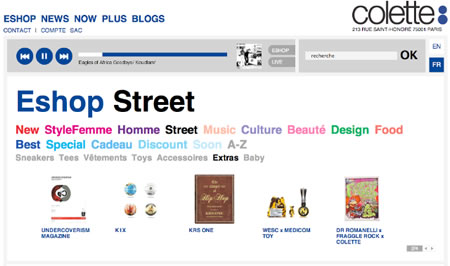
New shop, popped. All the time: Colette.
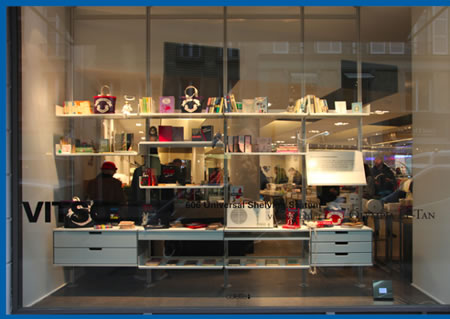
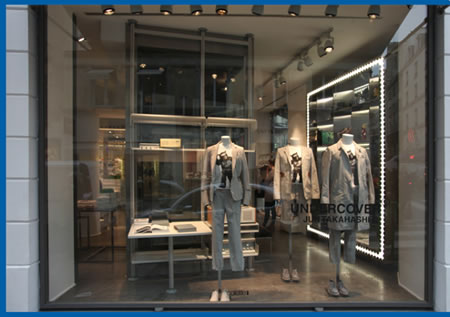
Maybe people will come in that way? Use the place as a promotional vehicle, like this Droid pitch, for Verizon’s new cast on Google phone modeling. Game, interactive, promotional — and, mostly, barely noticed. A building purchased, leasee removed and no replacement in years. Abandonment and surely demoralizing for the neighborhood. And during the current spate, looking worse than ever.
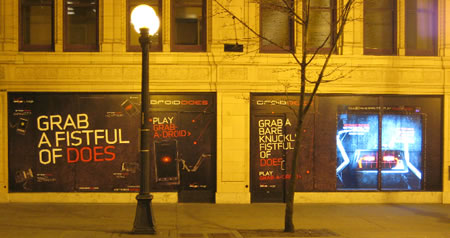
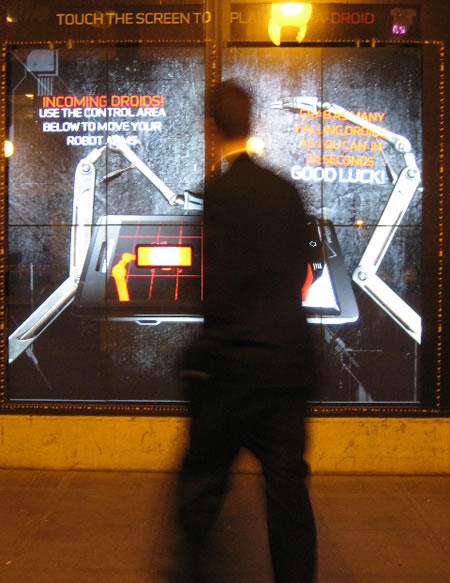
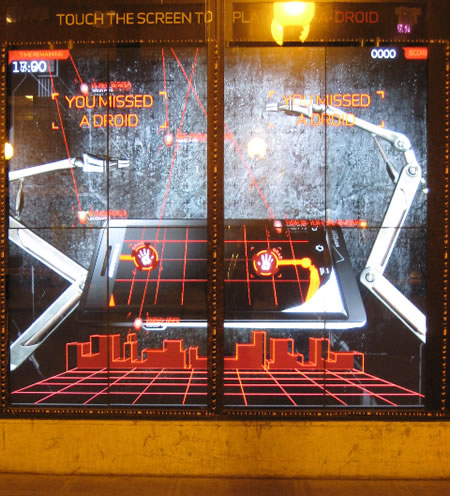
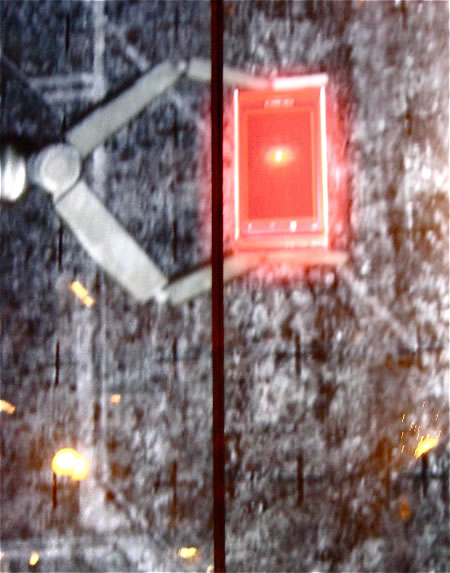
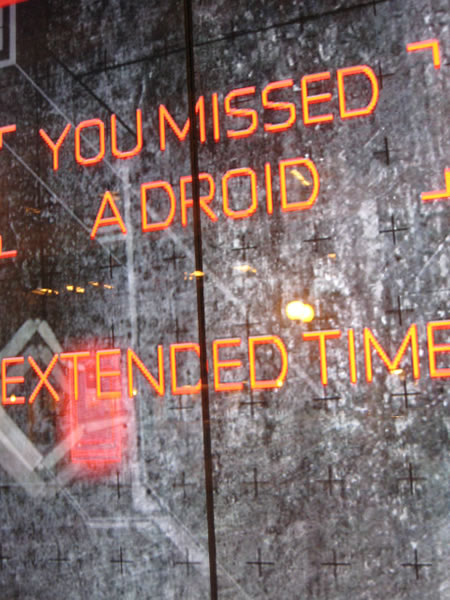
Another solution might be leaving the construction on hold, and being imaginative with the installations that contain the construction sites. That’s been a big challenge in NYC. Many building sites; they’re there: sites, with construction barricades. As projects, they’re dead, they’re stopped in the water.
What about converting that to more artful expressions — storytelling at streetscape?
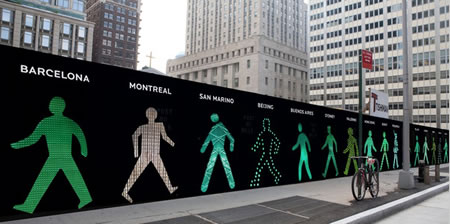
This image, from the New York Time’s photograph of Maya Barkai’s “Walking Men 99” at 99 Church Street, in the financial district, with 99 versions of the international “walking man” traffic sign.
Carol Vogel, notes “it has been more than eight years since the World Trade Center attack, every day it seems there are more cranes and concrete trucks, scaffolding and chain-link fences as Lower Manhattan struggles to rebuild. According to the Alliance for Downtown New York, a nonprofit business-improvement-district group, an estimated $30 billion worth of construction is going on at 190 sites below Canal Street.” The challenge is either the slow pace of action, or the impact of sluggish building in advancement. “The area is experiencing construction fatigue and, for a lot of people, it’s been a jarring experience,” said Elizabeth H. Berger, president of the alliance. “At the end of the day while these are improvements that advance Lower Manhattan, in the short term it’s tough.”
And the stakes are high: about 314,000 people who work in the area, 54,000 who live there and more than 5 million who visit the area every year. According to the article, at 99 Church Street, a 912-foot-tall residential and hotel tower — the tallest in New York — is being developed. But, it’s stalled — the project is in limbo pending financing. To brighten the streetscape, the Israeli-born photographer Maya Barkai has created “Walking Men 99.” Long fascinated by the walking-figure symbol that accompanies traffic crossings from around the world, she has composed a grouping of 99 examples of them marching side by side that will cover a plywood wall surrounding the property.
According to the overview on the projects by Carol Vogel, there are a sequence of these installations happening simultaneously. “Maya realized that not only does the symbol exist in every city, but she discovered that many of them are different,” said Ayelet Danielle Aldouby, a curator for ADA Art Consulting in Manhattan, who organized the project with her co-curator Elinor Milchan. “In Dresden there is a walking girl and in Fredericia, Denmark, a soldier. East Berlin has a little man wearing a hat.” She also has images of the silhouette of Hans Christian Andersen, the traffic symbol for Odense, Denmark, and Sophie, a pony-tailed female traffic sign in Utrecht, the Netherlands.
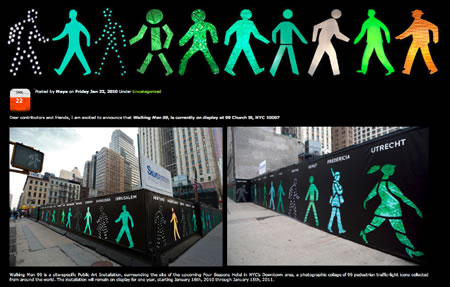
“Maya established a Web site where she asked people to submit photographs of walking men all over the world,” Ms. Aldouby added. “And then she put them together by city.” The project will be on view for a year.
Working in the context of real estate — and the absolute dearth of action in 2009 (simply everything is stalled to the point of hibernation), our reach was to find and create solutions in transforming parking lot construction sites into something more interesting, to explore the idea of rethinking space, and to build new conceptions of environment for un-leased and underutilized environments. We walked the walk.
Unfortunately, really, there were few that walked that saunter with us.
TSG
…….
Exploring branding
and patterning place | https://www.girvin.com/blog/?s=brand+patterning
Tim Girvin | GIRVIN
c. 206.890.0621
New York City + Seattle | Tokyo
the reels: http://www.youtube.com/user/GIRVIN888
girvin blogs:
http://blog.girvin.com/
https://tim.girvin.com/index.php
girvin profiles and communities:
TED: http://www.ted.com/index.php/profiles/view/id/825
Behance: http://www.behance.net/GIRVIN-Branding
Flickr: http://www.flickr.com/photos/tgirvin/
Google: http://www.google.com/profiles/timgirvin
LinkedIn: http://www.linkedin.com/in/timgirvin
Facebook: http://www.facebook.com/people/Tim-Girvin/644114347
Twitter: http://twitter.com/tgirvin